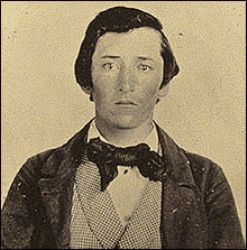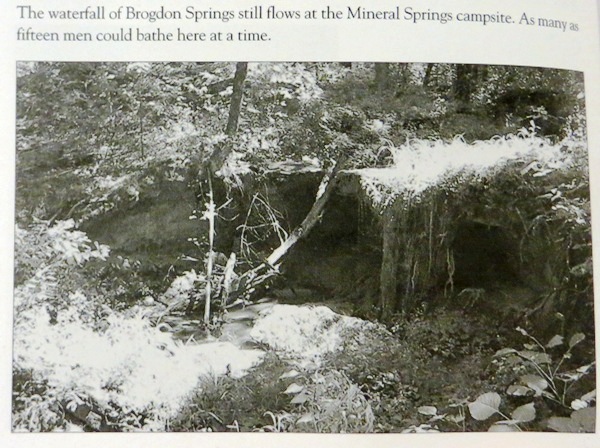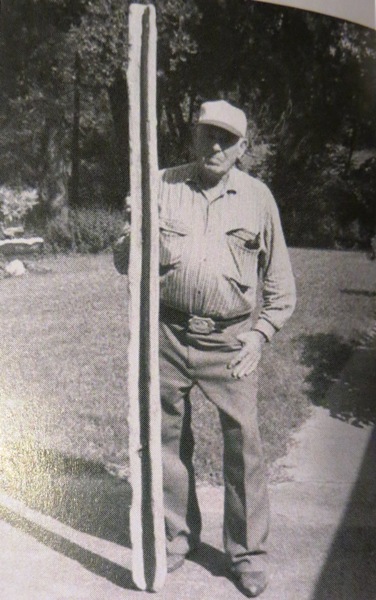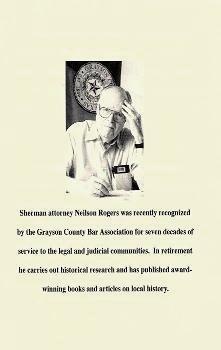|
William Clarke Quantrill William
Clark Quantrill had been a school teacher in Missouri. He enlisted in a
Confederate military unit in Oklahoma and served two tours of duty
during his six months as a soldier. Returning home, he was filled with
rage because of the cruelty and violence suffered by his friends and
members of his family.

Physical Description
Character Description
By Edward Southerland
Herald Democrat One of the lesser known, or perhaps lesser admitted, sides of the history of Sherman and Grayson County, is the area’s close connection to the lives and careers of the legendary Missouri outlaws Jesse and Frank James. The connection began in the early days of the Civil War with the activities of William Clarke Quantrill, notorious border guerilla chief, and continued beyond the death of Jesse James at the hand of Robert Ford in 1882. Much of this untold story will come to light the weekend of May 12 - 13, when Sherman celebrates Western Heritage Week. The theme for 2001 is “Ride the Outlaw Trail,” and, in addition to exhibits and the commemoration of a State of Texas Historical Marker on the Grayson County Courthouse lawn, historians and scholars, local and from around the country, will be on hand to discuss the time when Sherman was known as “Helldorado on the Crosstimbers.” His step-uncle was a Hart, originally from Ohio, but living on the eve of the Civil War, near Preston Bend in Grayson County. Using the alias Charlie Hart, instead of his own name, William Clarke Quantrill came down from the Missouri-Kansas border in March 1861 to visit his relatives. He was already established as a player in the violent clashes in “Bleeding Kansas.” All along the border and into Missouri the ongoing skirmishes, often by paramilitary groups, unfettered by ties to the regular military establishment, north or south, had produced a landscape sullied by the bitterness of mutually destructive warfare. He took notice of a population generally sympathetic to the southern cause, the good water and grass and an abundance of hiding places in the back country away from towns. This information might serve him well in the future. Indeed it did. The following fall, in November of 1862, Quantrill came back to Sherman with about 25 Missouri guerillas. They spent a quiet winter in the city before riding north in the spring and into the blacker pages of history. These came, when the loosely organized guerrilla band, now numbering over 200 hard case ruffians and veterans of the border wars, sacked the Unionist town of Lawrence, Kansas, murdering 150 men and boys of military age and at Baxter Springs, also in Kansas, where they cut up a Union army detachment in a stand-up fight. Riding with Quantrill were names destined to be written in blood across the history of the American Midwest – William T. Anderson, known as “Bloody Bill”, Frank James of Clay County, Missouri, and the Younger clan led by oldest brother Cole. These men, along with about 200 more, including Frank James’ younger brother Jesse, not yet old enough to be a combatant, accompanied Quantrill when the band descended on Sherman in November of 1863 to winter away from the war. This time, the stay was not so quiet. On Dec. 22, General Henry McCullough, Confederate commander of the Northern Sub-District of Texas in Bonham got word that the war was coming closer to the Red River Valley. In a telegram to Edmund Kirby Smith, chief of the southern armies in the Trans-Mississippi, he noted, “News of a reliable character reached me this morning that Jayhawkers (irregular Kansas unionist guerillas) in considerable force had penetrated Gainesville…Indians and Federal 400 strong. I sent all the cavalry force I had this morning at 8 o’clock, numbering only some 200 men from this place, directing Quantrill, from Sherman, to meet them at once.” Quantrill, not beholding to Confederate authority, refused to join the Confederate troopers. Instead he led his men across the Red River into the Indian Territory where they carefully prepared an ambush for the invading Federals. The blue coats, trying to avoid McCullough’s column blundered into the raiders and were cut to pieces. The next day, the victorious guerillas celebrated their victory by shooting up Sherman in a drunken orgy of wine, women and gunpowder. While no residents were hurt, the town took a beating. When the celebrants crashed a Christmas party in Ben Christian’s hotel, several gunmen took turns shooting the tassels off matriarch Sophie Porter’s bonnet. As the spring of 1864 came on, Quantrill’s continued presence in Sherman became a drain on the city and a thorn in the side of General McCullough. The idea of a large body of well-armed me in his territory, men whose loyalties and alms were questionable at best, bothered the general. The guerilla chief was having problems of his own that spring. His group was beginning to disintegrate. Never tightly organized, the raiders began to break up and drift off in different directions, oblivious to the needs of their erstwhile commander or the military situation. In March, against Quantrill’s wishes, Bill Anderson married a Sherman girl, Bush Smith, and set up his own detachment near College and Broughton streets. He was soon to go back to Kansas to follow his career of murder and mayhem and to meet his death. About that time, General McCullough ordered Quantrill to meet him in Bonham. When the raider arrived, he was arrested and jailed. He did not stay arrested for long. Escaping and making his way back to Sherman, Quantrill gathered all who would follow him, only 14 of the original 200 or so who had trooped in to Sherman the previous fall. They headed for Kentucky. There, he died at the hands of Union soldiers. Time had run out for the enigmatic shooting star that was William Clarke Quantrill. Not so his influence. At the close of the war, one of his chief lieutenants, William H. Gregg, led a bedraggled contingent of 50 refugee Missouri families on a harrowing trek through the Indian Territory to new lives in and around Sherman. 
Proud To Be A Soldier pg129 - 132 The
people of Sherman opened their homes and hospitality to the weary
refugees. Quantrill divided his command, keeping part of them in camp
outside Sherman. Most of the married men, like H. T. Ritter and Jim
Chiles, whose wives and families were with them, were housed more
comfortably in town. Only the married me were allowed to live in town;
single men were required to be billeted outside of town, per orders of
Gen. Henry E. McCulloch. Eventually the remainder of Quantrill's
command camped about fifteen miles north of Sherman, in an area called
Georgetown, just south of the Red River.
Quantrill picked the area known as Cross Timbers for his camp because of its abundant grazing lands. Here the terrain was similar to what they had known in Missouri. Protective woods surrounded a prairie of lush grasses, which supplied bountiful forage for horses. The camp was just southeast of the confluence of Big Mineral Creek and the Red River, near Brodgon Springs and east of the Bounds Ferry Road, one mile due south of the ferry and fifteen miles from Sherman. Fifty yards north of the campsite, an eight-foot waterfall at the confluence of Brogdon, Stout and Drippings springs cascaded into a deep pool on the east side of the Bounds Ferry road. The huge pool could accommodate as many as fifteen people, and the bathers were able to funnel water from a hidden hillside spring, and this proved to be very useful during dry spells. 
Quantrill
named the place Camp Lookout because it was situated at the highest
point in Grayson County and had a clear view of the countryside for
half a mile in all directions. The site offered a strong defensible
position with rocky bluffs and thick timber that skirted the
surrounding prairies.
Stationed also in the area was the Eleventh Texas Cavalry which had been organized near Preston. The Fifth Texas Cavalry was also quartered nearby. Also in the area was the Ninth Texas Cavalry consisting of volunteers from Cass, Grayson, Hunt, Hopkins, Lamar, Red River Tarrant and Titus counties. In the aftermath of a battle between Quantrill's men and the Federals, local farmers buried the slain Jayhawkers. Among the hundreds of Union gravesites lying near Quantrill's camp are memorials listing the fallen members of the Fourteenth Kansas Cavalry. Because of the rocky terrain, most were buried in shallow graves. 
Neal
Henderson lives near the site of Quantrill's camp at Mineral Springs,
Texas and displays a trough carved by Frank James to collect water from a hillside spring.



The Sunday
Gazetteer
Sunday, December 15, 1895 pg. 2 THE KILLING OF QUANTRELL Simon Horsley, a man who served with distinction under Gen. Forrester, died at the home of his brother near this place recently, says a Rogers, Arkansas letter. Intimate friends have known for some time that he knew of the killing of the noted rebel, Major Quantrell, but the fact did not become generally known until his death. Horsley was sent as a recruiting officer by Gen. Forrester into Kentucky, and as Quantrell was returning from a raid, he stopped in the vicinity of Bardstown and began depredations, not even respecting the property of southern people. Horsley, at the request of the citizens there, waited on Quantrell and asked him as a friend to desist, but the wiry Quantrell became angry and would not listen to the demand. He was warned to make no more raids on the property of Kentucky Confederates, and the two separated. It was in the spring of 1865, and Quantrell became desperate. He made another raid, and during an engagement with a detachment of Kentucky troops, Quantrell was killed. It has been generally understood that Quantrell was killed by federal troops, but men in a position to know of the facts were satisfied that he met his death at the hands of those who would have been his friends but for his rash act in trespassing upon the property of both friend and foe. Horsley was a reliable citizen and confided secrets to his Masonic friends that they would not divulge as long as he lived. Now that he is dead, they are willing to supply this missing link in the "lost cause," and do all possible to enlighten the end of Quantrell's exciting career. Capt. Horsley was a law abiding citizen, and his death is greatly regretted. 
Quantrills Guerrillas Biography Index
If you find any of Grayson County TXGenWeb links inoperable, please send me a message. |


